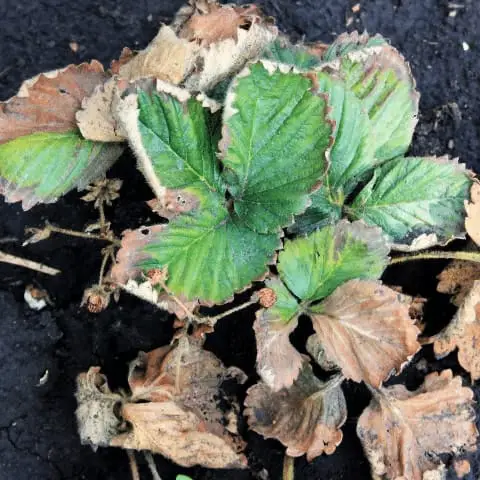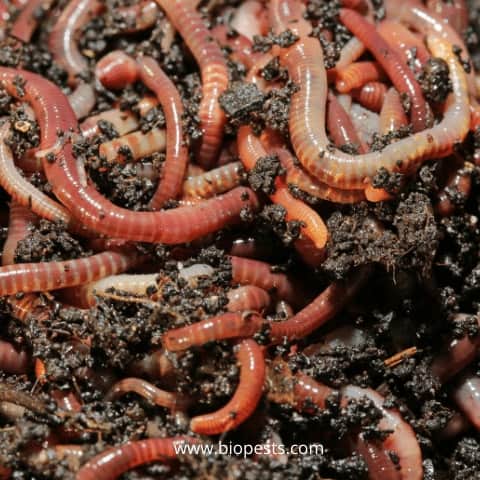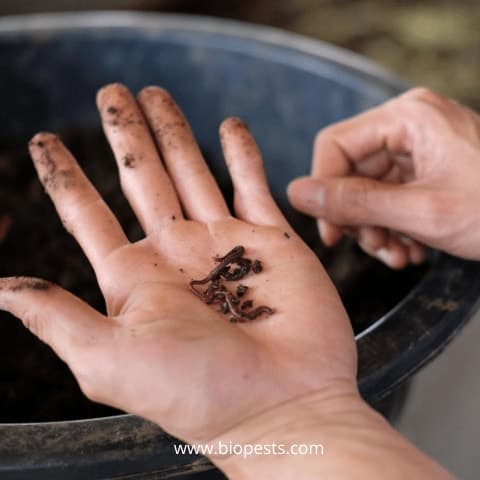If you have noticed fruit rotting or a rapid yellowing of the leaves in your garden, your plants are likely affected by a fungus called Fusarium. Fusarium is a large genus of soil fungi widely distributed in the world. Some Fusarium species have a devastating impact on crops.
Among the most important species, it’s worth mentioning the Fusarium Oxysporium. The development of this fungus is favored by a hot-humid climate, the presence of water stagnation, infected or poor soil, or the recycling of infected containers.
The main symptoms of fusarium infestation are collar rot, lesions and yellowing of the leaves, necrosis of the stems, fruit rot, and post-harvest decomposition.
Crops that are attacked by this fungus die quickly if not treated right away, as it is a highly dangerous and aggressive disease.
Among the ornamental plants most affected by this fungus are:
- cyclamen, carnation, chrysanthemums, bulbous plants and herbaceous plants in general;
This fungus has a particular preference especially for:
- strawberry, tomato, cotton, lettuce, cabbage, wheat, peas and celery.

What to do to prevent Fusarium infestation?
As with all things, prevention is the best cure.
The defense against plant fusarium starts with the adoption of some main preventive measures, such as the following:
• adequate soil pH;
• destruction of crop residues;
• selection of resistant cultivars;
• use of a high quality substrate;
• disinfestation of all the equipment (tools, containers, machinery and irrigation systems)
• application of nitrogen in the form of nitrate;
• ensure adequate soil drainage.
Luckily, nature has provided us with a silent, humble hard-working ally to fulfill most of these tasks and restore our soil: the earthworm.
This amazing worm is considered a beneficial insect for our gardens for a good reason! It does such an extraordinary job that after reading this article you will be convinced that growing earthworms is vital for your plants.
What are the benefits of the earthworm?
Earthworm is the common name for the largest members of Oligochaeta species. Its size varies from 0.39 to 14 inches, depending on the species. Earthworms live in the ground, dig deep tunnels and swallow earth as they pass through. They love to live in damp soil during the day, only to emerge at night and feed on debris collected on the surface.
Summarizing the work of earthworms, these little guys dig tunnels in compact soil, they make their way by crushing it and swallowing it. The soil passes into their intestine where it is further processed. Earthworms produce something called Worm Humus or vermicompost, which is different in shape and characteristics from that swallowed.
Earthworm dejections (ehm…worm poop) contain organic substance and nutrient principles in a higher quantity than the starting soil. Just to give you an idea of soil improvement in percentages, here is a table that illustrates it:
| Organic Substance | + 50% |
| Calcium | + 150% |
| Magnesium | + 300% |
| Nitrogen | + 500% |
| Phosphorus | + 700% |
| Potassium | + 1000% |
Here are just few facts about the effects of the work done by earthworms:
1. By digging tunnels, earthworms mix the layers of the soil, bringing the subsoil to the surface and incorporating it into the soil.
2. Earthworm tunnels allow air and water to penetrate to the deepest layers of the soil. The more air in the soil, the easier will be for the roots to develop underground. We can without a doubt say that the earthworm is the best tool against water stagnation.
3. By digging tunnels earthworms mix large quantities of organic material, allowing the micro-organisms found in the soil to demolish organic substances and produce humus more easily. Humus is the best source of nutrients for plants: it is packed with minerals that are essential for plant growth, especially nitrogen.
4. The combination of soft soil and humus in the manure of worms produces over time an ideal consistency soil that promotes the growth of organisms and increases the fertility of the soil itself, facilitating the cultivation of plants. The presence of earthworms indicates that the soil is healthy and PH balanced: not too alkaline nor acidic.
5. Earthworms drag food into the tunnels, freeing the soil of dead leaves and twigs.
Moistening, mixing, and decomposition are the main activities carried out by the earthworm. It feeds on plant and animal residues and, during ingestion, takes on significant quantities of micro-organisms (bacteria and fungi ) whose spores are eliminated with feces and distributed in a large area. The intestinal flora of the earthworm is a humus-generating flora and the organic matter produced is ideal for improving the physiological condition of your plants.
Summarizing the above, earthworms fertilize the earth, increasing the resistance of plants. There is a clear correlation between productivity and the presence of earthworms.
If you want to encourage a healthy population of worms in your garden, here are a few things you can do to help them:
- Do not till your soil (or do it as little as possible)
- Leave organic matter on the surface
- Add manure and compost to your soil
- Do not use chemical pesticides or fertilizers
- Keep the soil moist by using organic mulch
Where to get earthworms and how to start a worm farm
What about those who don’t have a garden, but still want to benefit from earthworms?
I have some good news for you! Earthworms can be bred anywhere! Worm farms don’t take much room and are extremely adaptable to almost any kind of weather and to different types of soil. If they have nourishment and water they proliferate producing their precious humus.
Literally, anyone can start a small worm farm today!
You can place the tray bin on the balcony or in any outdoor space. Choose a shady place for your worm farm.
With a simple tray, about 10 square feet, you can install a micro worming farm, using your organic kitchen waste and obtaining a high-quality natural fertilizer at zero cost.
There is nothing more ecological than a home-made compost, that allows you to directly dispose of your organic household waste. You will always have availble excellent compost or humus, ideal for fertilizing potted plants on your garden or balcony. By realizing a home breeding, you will no longer have to depend on the purchase of earthworms or on the ready-made humus which in many cases can cost a lot.
Earthworms can be grown in any container, such as a vase or a wooden box. The worms can easily be fed with organic kitchen waste; just make sure to keep their soil wet.
What are the best composting bins for worms
You can definitely build your own worm farm by using wooden boards 40″x 24″. As an alternative, you can recycle something you already have at home and use a smaller container. The base must be drilled to allow the passage and drainage of water.
An optimal solution is the stacked worm composter bin, composed of a stacking system of connected worm bins or trays, and equipped with a tap to collect the liquid (Composte Tea).
A good idea is to have it on wheels, allowing small movements and easy cleaning of the terrace/garage if necessary. If you don’t feel like making it yourself, I would personally recommend this stacked bin worm composter that can be purchased online on Amazon.

How do I start a worm farm?
- Earthworms do not self-generate so you must purchase them at least at the beginning of the breeding. As a matter of fact, not all species of earthworms are suitable for the job. Generally, the most used ones belong to two species: the red wigglers (Eisenia fetida) and red worms (Lumbricus rubellus). Compost worms are different from worms you would normally find in your garden. Let’s say compost worms work faster than the latter ones.
2. The earthworms will initially be placed in a compound called vermiculite which will serve as the basis for their “meals”. Vegetable waste and / or animal manure will then be added periodically. The compound in which they will grow must be kept moist. Make sure your worm farm never dries out!
3. The easiest nutrient to supply is an organic compost, that is, kitchen waste. This is especially true for small home breeding. But be careful, you can’t throw everything to the worms. There are certain foods like acidic ones that should not to be given. Earthworms really appreciate manure.
4. When the earthworms begin to multiply, the amount of humus produced will increase proportionally generally after about 6 months of breeding, the first humus can be collected. The ready-to-use layer is the one below because earthworms tend to move upwards as they are always looking for new food.
Do earthworms stink?
Since one of the tasks of earthworms is the decomposition of food, it is legitimate to wonder if having a composter bin on your balcony or near your home has a smelly issue.
The presence of a small compost bin near the house does not bother: a correct composting process does not stink, especially if this process is done correctly.
The only thing that bothers a bit is… the noise you hear when lifting the lid of the bin. I’ll leave it to your immagination. (let’s face it, they are slightly disgusting)!
Fun facts about earthworms…
These little pink worms never cease to amaze me! Here are 8 fun facts about them:
- The earthworm has both sexes in it and when mating it is fertile and is fertilized simultaneously. If the earthworm does not find a partner, it can self-fertilize!
- Its eggs are able to survive a long time until conditions are suitable for hatching.
- The earthworm has no lungs. It breathes oxygen by absorbing it throughout its body
- It can digest anything. Even stones.
- Every day, earthworms eat and process food more than their own body weight.
- Earthworms studied in captivity showed no signs of aging. This led scientists to believe that in ideal conditions the earthworm could live forever!
- In normal circumstances, their life span is from 2 to 8 years.
- If you cut an earthworm in two parts you will get… only a worm and a half (and NOT two worms)! The amazing thing is that earthworms have the capability of regenerating themselves and of growing back the missing part.
It looks like earthworms have the skills of a highlander and I have no doubt, they will be the ones to survive the end of the world!
Not bad for a little pink worm.
Some of the links above are affiliate links, meaning, at no additional cost to you, I will earn a commission if you click through and make a purchase.



